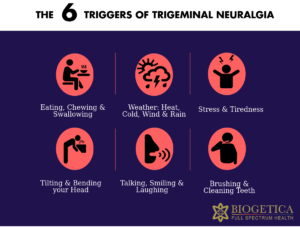Tags
biogetica.com, mandibular, maxillary, nerve pain, ophthalmic, TN, trigeminal, Trigeminal Neuralgia
What would it be like to live without worrying about when the next bout of pain will strike? Wouldn’t it be wonderful to get back the life you once enjoyed? After all, no one wants to think twice before smiling, talking or enjoying a breeze. However, these simple and natural actions among many others are triggers for Trigeminal Neuralgia (TN) patients who then have to endure unbearable pain. TN is a debilitating condition that tends to progress with time and masking its pain without addressing its root cause worsens the condition each day.
Trigeminal Neuralgia is a disease characterized by the paroxysmal occurrence of neuralgic pains within the distribution of one or more divisions of the trigeminal nerve. The branches of the trigeminal nerve are spread over the face, from the jaw to the forehead. Affections of this nerve cause episode of excruciating pain, which are short-lived and on one side of the face. Even a mild sensation like a gentle breeze or a splash of water could trigger an attack. It is one of the most painful afflictions of the human body. It affects mainly middle-aged, geriatric individuals and is more common in women.

Trigeminal Neuralgia Causes
The trigeminal nerve, as its name suggests, has 3 branches – ophthalmic, maxillary and mandibular, in different parts of the face.
The cause and mechanism of Trigeminal Neuralgia are subjects of controversy. In general, certain situations have been hypothesized as causative factors:
1. Disruption of the nerve’s function in an artery or vein as it leaves the brainstem. When a blood vessel comes into contact with the nerve, it applies pressure on it resulting in a painful response as the protective sheath (myelin) surrounding the nerve is eroded.
2. Sometimes a tumor growing in the area, a local aneurysm, multiple sclerosis, or a brain lesion compresses the nerve resulting in pain.
3. In other cases, surgical traumas by accidents involving the face, stroke, head injuries or dental infections caused by botched up extractions may set off TN
4. Besides these, there are many mild stimuli that can also trigger off the pain. These include:
- Stroking the face
- Brushing teeth
- Shaving
- Eating
- Smiling
- Wave of cold breeze
Signs and Symptoms of Trigeminal Neuralgia (TN)
Pain, alone, is the most distinguishing feature of this disorder. It has a distinct predilection for the right side. Occasionally, the pain is on both sides, but this is rare. The lower jaw is more commonly affected than the upper jaw.
Pain occurs during the day, and rarely at night. It occurs in paroxysms (spasms) and strikes like a flash of lightning. Each paroxysm consists of a cluster of ‘lancinating’ or ‘shock like’ pains that some patients describe to be like ‘an explosion of fireworks on the face’. Paroxysms last for a minute or two each and recur many times during the day. Barring anxiety, the patient is pain-free between the paroxysms.
An attack may be precipitated by touching certain spots on the face or even a breeze on the face. Movements of the face such as talking, smiling or eating can also trigger the episodes. It is common to see such a patient with one side of his face unshaved and unwashed for days, with the tongue and teeth remain coated.
During the attack, the patient may show hideous contortions of the face, hold that side of the face immobile, or rub it with a handkerchief to thwart the attack.
Such attacks of trigeminal neuralgia pain may continue for days, followed by periods of remission that last for weeks, months or years. Usually, such intervals become progressively shorter and each recurrence grows more severe.
Diagnosis of Trigeminal Neuralgia (TN)
The typical pain of Trigeminal Neuralgia is sufficient for diagnosing the condition. Other causes of facial pain, like teeth or gum disorders, should be ruled out, nonetheless.
A neurological examination done by touching the affected part helps confirm the diagnosis.
If required, a plain X-ray of the skull and a CT scan may be done.
Source (above) – https://www.biogetica.com
Trigeminal neuralgia is a chronic pain condition that affects the trigeminal nerve, which carries sensation from your face to your brain.
If you have trigeminal neuralgia, even mild stimulation of your face — such as from brushing your teeth or putting on makeup — may trigger a jolt of excruciating pain. You may initially experience short, mild attacks. But trigeminal neuralgia can progress and cause longer, more-frequent bouts of searing pain. Trigeminal neuralgia affects women more often than men, and it’s more likely to occur in people who are older than 50.
Symptoms
- Episodes of severe, shooting or jabbing pain that may feel like an electric shock
- Spontaneous attacks of pain or attacks triggered by things such as touching the face, chewing, speaking or brushing teeth
- Bouts of pain lasting from a few seconds to several minutes
- Episodes of several attacks lasting days, weeks, months or longer — some people have periods when they experience no pain
- Constant aching, burning feeling that may occur before it evolves into the spasm-like pain of trigeminal neuralgia
- Pain in areas supplied by the trigeminal nerve, including the cheek, jaw, teeth, gums, lips, or less often the eye and forehead
- Pain affecting one side of the face at a time, though may rarely affect both sides of the face
- Pain focused in one spot or spread in a wider pattern
Causes
In trigeminal neuralgia, also called tic douloureux, the trigeminal nerve’s function is disrupted.
Usually, the problem is contact between a normal blood vessel — in this case, an artery or a vein — and the trigeminal nerve at the base of your brain. This contact puts pressure on the nerve and causes it to malfunction. Trigeminal neuralgia can occur as a result of aging, or it can be related to multiple sclerosis or a similar disorder that damages the myelin sheath protecting certain nerves.
Trigeminal neuralgia can also be caused by a tumor compressing the trigeminal nerve.
Some people may experience trigeminal neuralgia due to a brain lesion or other abnormalities. In other cases, surgical injuries, stroke or facial trauma may be responsible for trigeminal neuralgia.
Triggers
A variety of triggers may set off the pain of trigeminal neuralgia, including:

- Shaving
- Touching your face
- Eating
- Drinking
- Brushing your teeth
- Talking
- Putting on makeup
- Encountering a breeze
- Smiling
- Washing your face
Source – https://facty.com/ailments/body/what-are-the-symptoms-of-trigeminal-neuralgia
